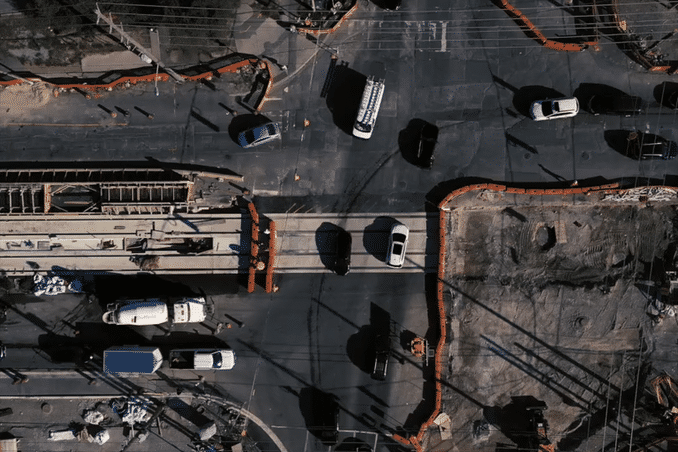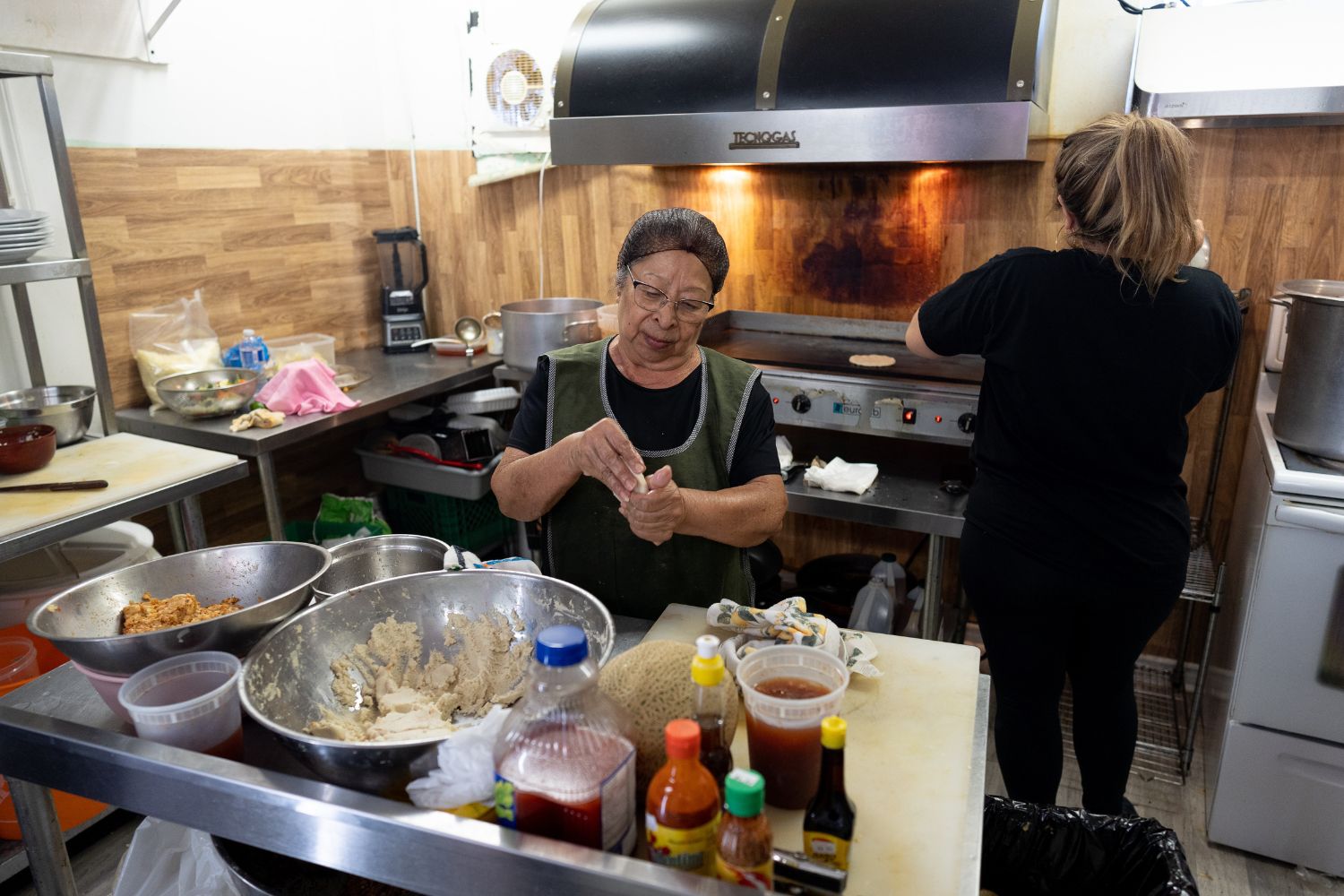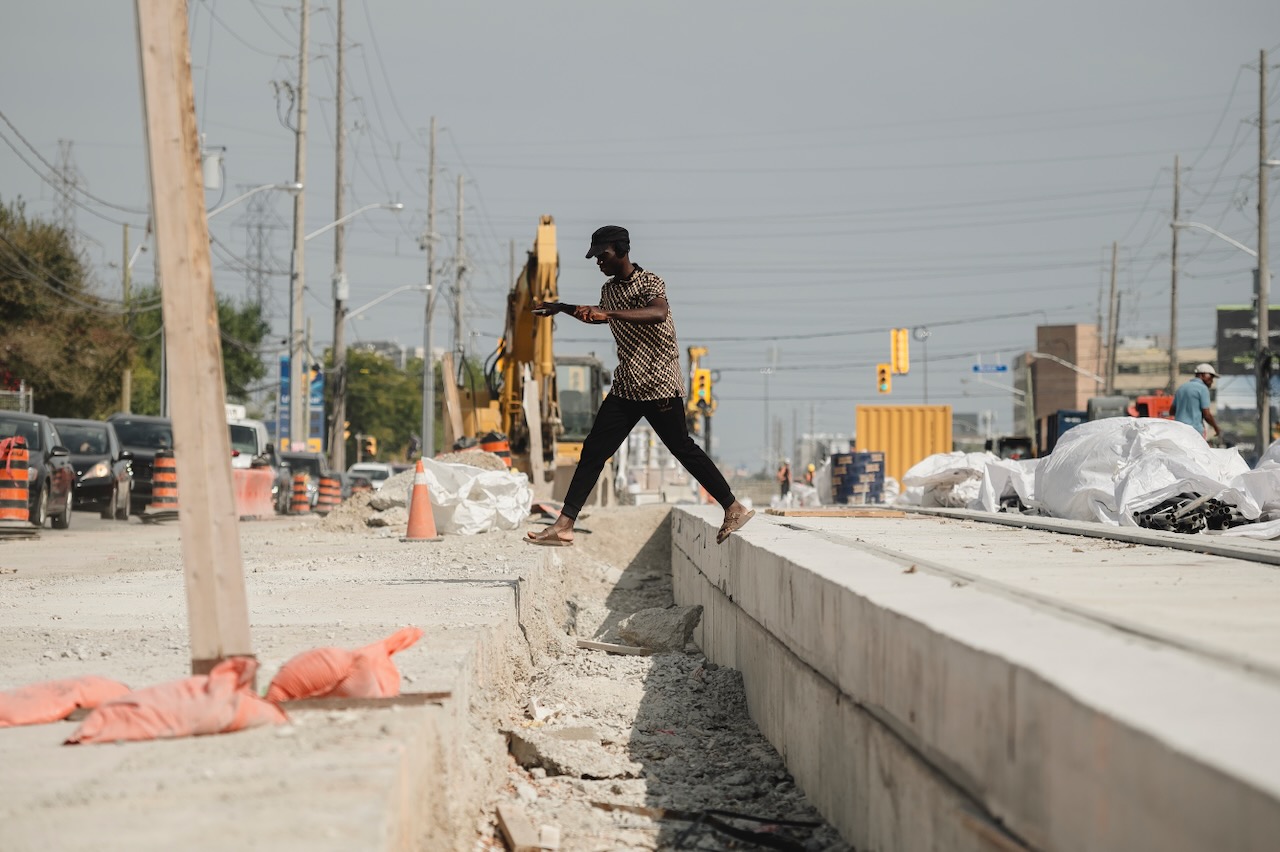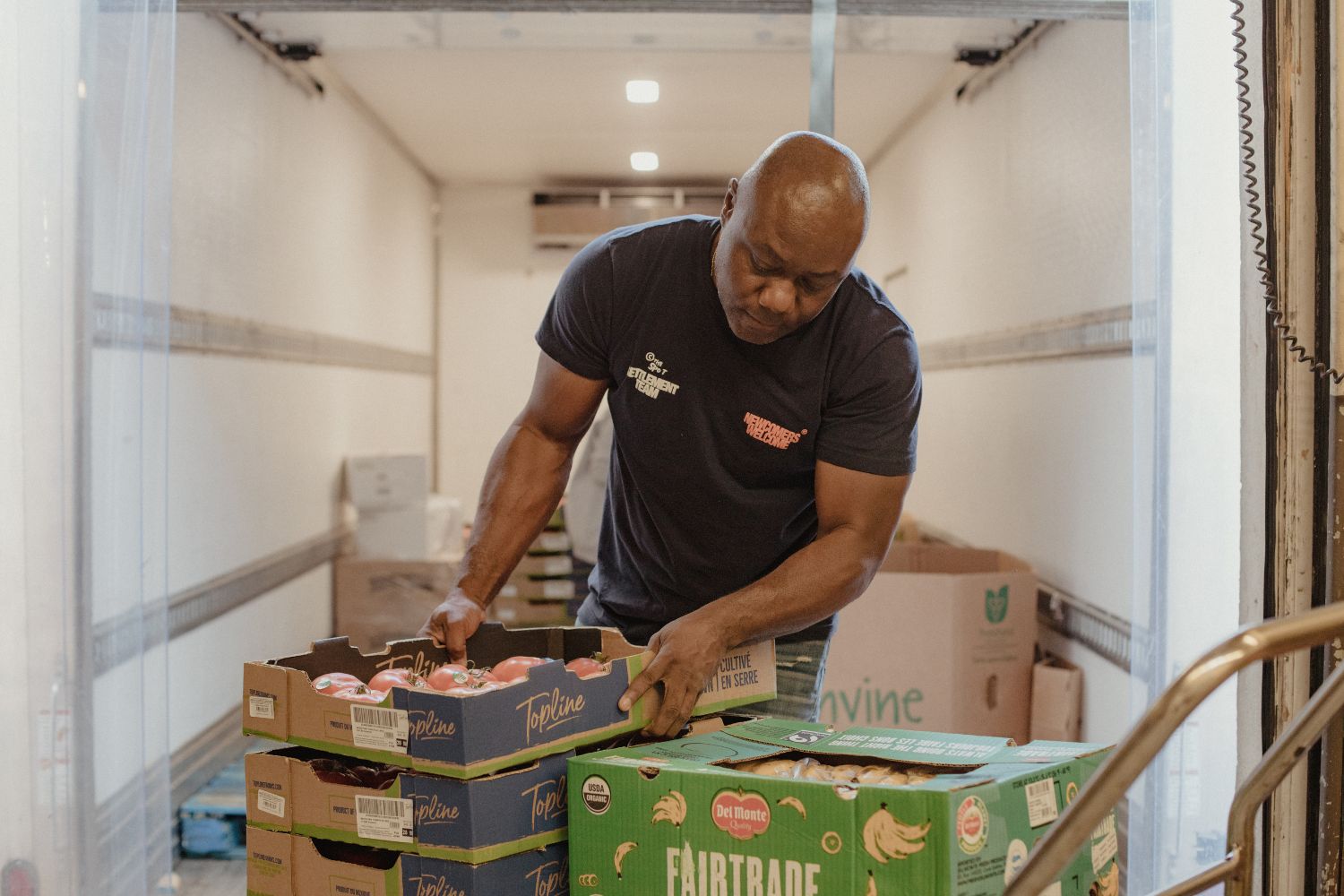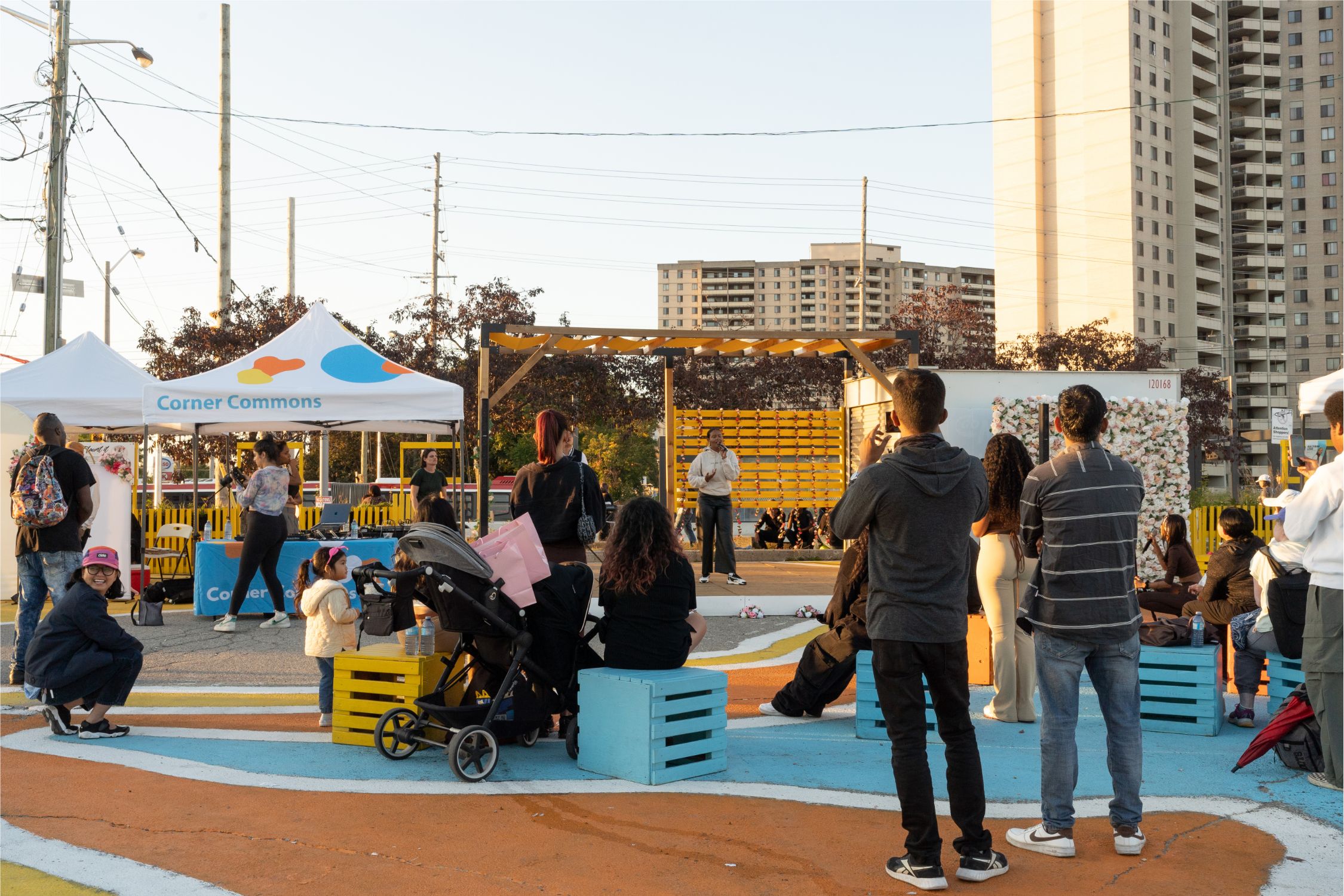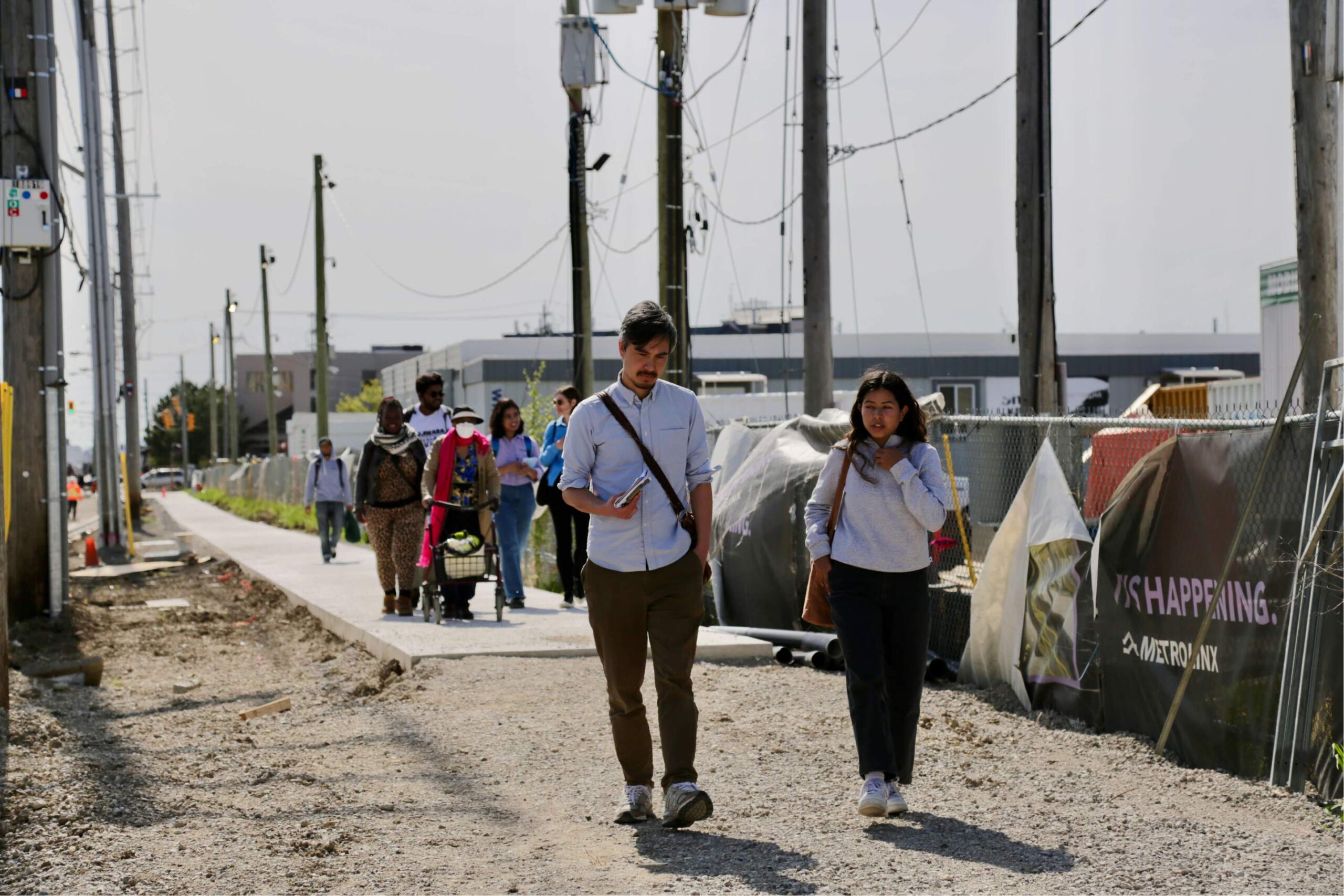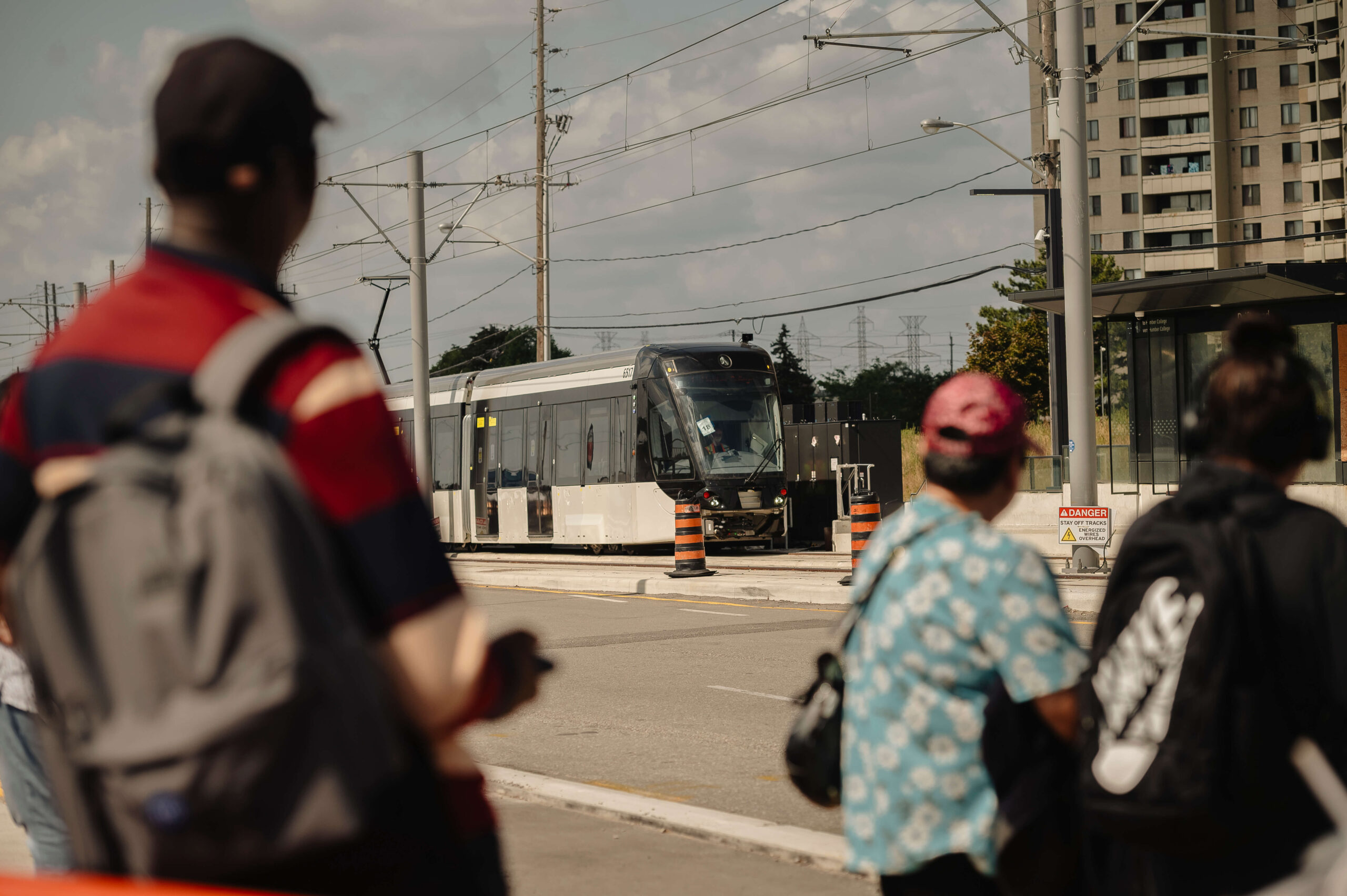
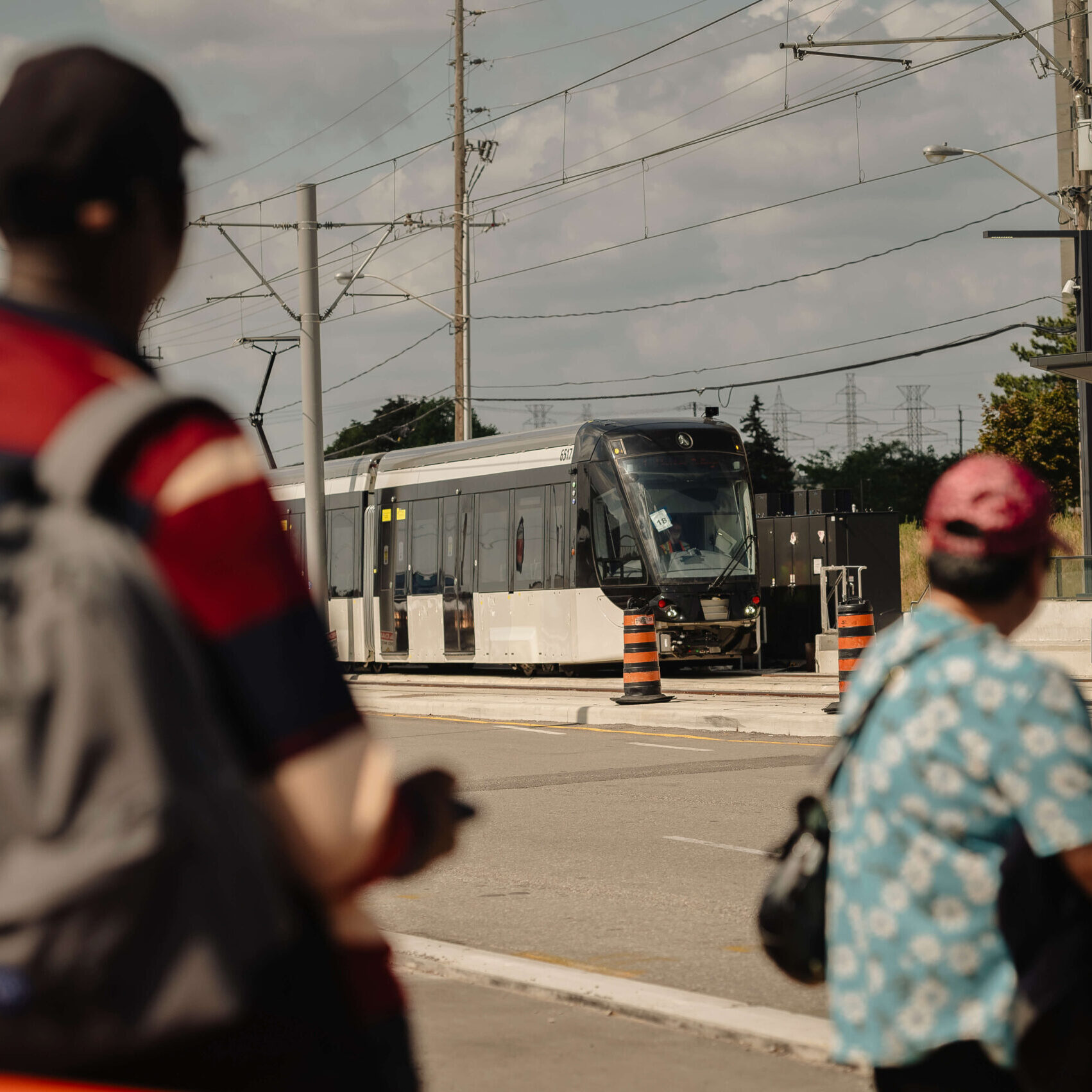
Anna-Kay Brown measures the progress of the Finch West Light Rail Transit (LRT) by milestones in her children’s lives. Her eldest son was born just a year after the original iteration of the project was announced in 2007. By the time Brown first started talking to locals about the LRT in 2018, in her capacity as community benefits framework coordinator at the Jane/Finch Centre, her youngest daughter was on the way. More than ten years had passed, and the idea of a rapid transit project in her neighbourhood had already been proposed, planned, and cancelled, only to be resurrected once more.
“At first, we were handing out pamphlets, just giving folks a little bit of information,” Brown says. “Some of them, you know, it was just their first time hearing about it.”
She would watch them process the news in real-time: Finch West was going to be radically and permanently changed. If done right, it would be hugely beneficial—but it wasn’t all that simple. “This major transit line was coming in, there was going to be major redevelopment, including gentrification and displacement.”
The Finch West LRT is an 18-stop line, 10-kilometre transit line built by provincial agency Metrolinx that sweeps across northwest Toronto. With its own right-of-way down the centre of the street, the LRT promises to get riders from Finch West station to Humber College in a little over 30 minutes; at rush hour now, that same trip on the bus takes over an hour. Once operational—it’s projected to open next year, according to the latest from Metrolinx—the LRT will be run by the TTC, and Metrolinx estimates it will serve 12 million riders a year by the end of this decade.
The line is the quiet middle child of Metrolinx’s Toronto developments, ignored in favour of the bigger, more expensive projects closer to the downtown core, like the Ontario Line and Eglinton Crosstown. It’s talked about so little that many outside the area aren’t aware it’s happening. But to locals in a part of the city with no rapid transit to speak of (not even, inexplicably, an express bus), a project of this scale can’t help but feel personal. It’s unavoidable, for one: the last few years of construction have fundamentally changed how residents and business owners interact with their communities. It’s also long overdue. The first plan for rapid transit along Finch was introduced in the late 60s, and projects have been cancelled four times (at least) since then. Anyone living near the arterial road in the last decade and a half has heard some version of the promise of rapid transit, reneged on ceaselessly and senselessly by politicians and bureaucrats.
The line also passes through neighbourhoods that have been historically neglected—racialized, immigrant, and lower- and middle-income residents who have long been ignored by their municipal and provincial governments. The new LRT will transform their connection with the rest of the city, connecting northwest Toronto to the subway system and the downtown core, bringing new investment and improved infrastructure—including a dedicated bike lane along Finch—and promising new housing. But in doing so, it also threatens to radically change the area through accompanying redevelopment, potentially displacing and pricing out residents and business owners who’ve made a life in one of the few remaining pockets of affordable rent in the city. Already, housing is changing hands, rents in some buildings are going up, business owners are giving up their leases, and no one is quite certain of what comes next, though not for a lack of trying to find out. Over the 15 years of ups and downs since this version of the LRT was first proposed, residents have had questions about how they can be part of the decisions that will come to shape their community, and how the project will change life along Finch West—who it’ll bring into the area from elsewhere in the city, and who it’ll push out.
For as long as there’s been a Jane-Finch, a Rexdale, a Humber College to develop, there’s been a distant politician who thinks he has the answer to the region’s transit problems. The result has been a series of legacy-building vanity projects volleyed from premier to premier to mayor—men sitting in offices worlds away from the 36 Finch bus—with no actual transit to show for it.
One of the earliest proposals for rail transit along Finch Avenue West was a 1969 TTC streetcar plan connecting the two ends of the Bloor-Danforth subway line, its route looping through the inner suburbs. That was scrapped in the 70s, in favour of then-premier Bill Davis’ GO-URBAN plan, whose foundational premise was: subways are out, magnetic levitation is in.
That plan—which promised to bring transit to Finch via West German technology that used magnets to hover driverless transit cars in the air along an elevated track—was scrapped when prototypes failed in Germany. It was briefly replaced by Davis’ 1982 Advanced Light Rail Transit plan, which proposed a regional transit system from Hamilton to Oshawa, with a northern branch along Finch—a project that died when he left office in 1985.
For most of the next two decades, as aspirational transit schemes with names like “GO-ALRT,” “Let’s Move,” and the “Rapid Transit Expansion Program” bloomed and then withered, the hopes for Finch Ave. lay gathering moss at the far end of a graveyard of abandoned metropolitan transit plans.
Then, in 2003, David Miller was sworn in as mayor—a councillor with a history of public transportation advocacy, and a man who talked about a childhood spent riding buses and the relationship between transit and social inclusion.
In 2007, Miller and TTC Chair Adam Giambrone officially proposed Transit City: seven light rail projects meant to connect underserved parts of Toronto to existing networks. For the first time in decades, Finch Ave. was a priority again; the unceasing and overwhelming demand for the 36 Finch bus, one of the most heavily trafficked bus routes in the city, had not gone unnoticed. The province and then-new provincial transit authority Metrolinx got on board, taking on the responsibility of funding the development and gaining more decision-making power in the process.
Then came the cuts. Premier Dalton McGuinty, who had in 2009 announced $9 billion in funding for transit development, including the Eglinton and Finch LRTs, made $4 billion in cuts in 2010. The setback was the first step in the plan’s downfall.
“The sad thing has always been that when Transit City was launched, at that point we thought David was going to serve a third term,” says Toronto transit expert Steve Munro. Advocates knew that Miller would inevitably be replaced by someone who would quash his vision for transit in favour of their own. “When David decided he wasn’t going to run for a third term, that was really the death of Transit City.”
“It’s Dalton McGuinty’s fault,” says David Miller of Transit City’s demise, 13 years later.
“He stopped the funding for [the Finch LRT] in the 2010 budget once I’d announced I wasn’t running again,” he says. “By doing that, he opened the door for Ford.”
Local Journalism Matters.
We're able to produce impactful, award-winning journalism thanks to the generous support of readers. By supporting The Local, you're contributing to a new kind of journalism—in-depth, non-profit, from corners of Toronto too often overlooked.
SupportRob Ford, Miller’s successor, cancelled Transit City on his first day in office, a move that the TTC later said would cost the city $65 million, and that may even have been beyond his legal authority.
Ford wanted subways. They were more expensive, had a more disruptive construction process, and weren’t necessary for the ridership demand along Finch—but they wouldn’t be an impediment to cars on the street, and that was the priority. It was a costly, inefficient option that had an obvious, pre-existing solution to it. But “council just rolled over,” says Munro.
The way this was communicated to the residents of northwestern Toronto was through a campaign denigrating the strengths and benefits of the LRT, and touting the subway as the only clear solution to the question of transit in the 21st century.
“It was almost downright ugly,” says Anthony Perruzza, longtime city councillor for Humber River-Black Creek, the ward through which much of the Finch West LRT runs. One of the most misleading elements of the rhetoric, in Perruzza’s memory, was how those opposed to the LRT described it as a trolley, evoking images of transit developments from a century past.
“The arguments were fallacious, language was being used that was confusing people,” he says. “I get it, it’ll be a little less comfortable and convenient for drivers, and that kind of thing, but it’ll make Finch Avenue work better for drivers, for [everyone].”
It was more than a year of this before council’s united efforts put the Finch and Eglinton LRTs back on the table: on February 8, 2012, council voted 25-18 to bring Finch and Eglinton back above ground, among other rapid transit plans. After the vote, Ford dismissed it as irrelevant, but Metrolinx agreed to the plan later that spring, and suddenly, the dream of rapid transit on Finch Ave. West felt achievable again.
While the 2010-2012 debacle was the last existential threat to rapid transit on Finch, Metrolinx’s “structural incompetence,” as Miller puts it, contributed to the line’s delays upon delays. Before 2010, the Finch line was expected to open in 2015; that was pushed to 2018, then 2020. Construction actually began in 2019 with the promise of a 2023 opening, which has since quietly turned into 2024.
The history of transit on Finch reveals the constant power struggle between the city and the province: the province thinks it knows better than the city, each successive premier thinks he knows better than the last, and meanwhile, decades worth of residents who need to get from one end of the inner suburbs to the other are left taking the bus. The threat posed by the province and Metrolinx—to the city’s transit infrastructure, to the power of the TTC, and resultantly to the weight of any one Torontonian’s vote on transit development—is still very real for the Toronto transit plans of the future.
“The people of Toronto are the ones who should decide, collectively, through the people they elect, where and how they want transit built,” says Miller. “The province has people who know nothing about the city, don’t understand any of the nuances, who maybe come down for a Blue Jays game—and they’re the ones in the end making decisions about where transit should go. It’s ludicrous.”
“This has been going on for 40 or 50 years,” says Miller. “And the current outcome is fundamentally undemocratic.”
Join the thousands of Torontonians who've signed up for our free newsletter and get award-winning local journalism delivered to your inbox.
"*" indicates required fields
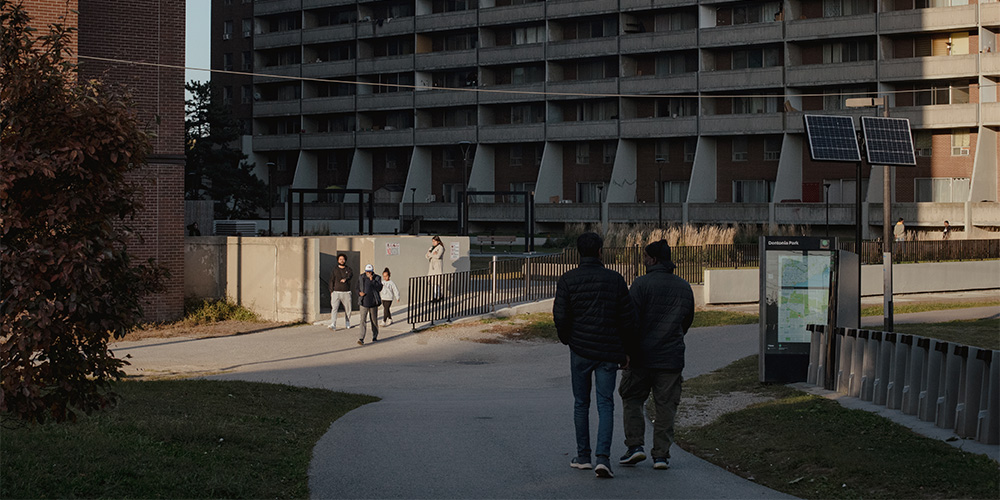
On a rainy Thursday afternoon in August, the North York Sikh Temple on Finch, just west of Weston, is mostly empty, and Gurdeep Singh is worried about the people who are missing. Many of the usual attendees are older immigrants or international postsecondary students, who come for free meals, help with their job searches, or just for community. Both groups rely on public transit, and as construction in the area has worsened over the last year, temple elders like Singh have seen attendance drop off.
“The businesses next door are suffering too,” Singh tells me in Hindi. The dust, the traffic, the transit conditions—nobody likes coming here anymore.
When the line is done, it’ll be good, Singh knows. But the crux of the matter is that it doesn’t really matter if northwestern Toronto is connected to the rest of the city if there are no jobs for the people who live here. “We have nothing to do with downtown. Our business is with this road, right here.”
“I don’t know if it’s the whole world, the whole country, but there’s no jobs. The kids don’t have jobs, everyone’s looking for jobs,” Singh says. “How will they eat? How will they pay rent?”
Singh claps a hand on the shoulder of the young man sitting with us. Faraaz Rahman has a postgraduate work visa, and moved from India to Canada a year ago, working first at Ikea, then Pizza Hut, then with a nonprofit centre for women. Singh tries to take care of him where he can. “He’s been struggling to find work too,” Singh says, “for six months.”
For five of those months, Rahman has lived in the area, and experienced all the challenges that come with LRT construction. But he’s optimistic. “Yes, these are problems,” he says, “But [I must] be positive that we have something great going on here, which will benefit the masses.”

The question of jobs has been central to the fight for community benefits on the Finch West LRT development, going as far back as when the project was first announced in 2007.
Then, northwest Toronto was still recovering from the so-called “summer of the gun” two years prior, and facing continued municipal neglect. Policing and surveillance had increased in the area, community organizations had lost funding and closed their doors, and congested transit was failing the thousands of local residents travelling out of the suburb for work through temp agencies. This was an area made up of racialized people, of immigrants, of families living in intergenerational homes in some of the last pockets of affordable housing in the city. And here was an opportunity to have some say in a development that was inevitably going to change the landscape of their neighbourhood.
“When this Transit City proposal was launched, I think a lot of people were really distrustful of how our communities were going to be included, and how long it was going to take, and just not being heard,” says Butterfly Gopaul, a resident member of Jane and Finch Action Against Poverty (JFAAP), a community advocacy organization formed in 2008. “We started really pushing work around community benefit frameworks.”
JFAAP and other community organizations were asking questions about how the inevitable changes could work for them: how they could foster affordable and reasonable housing developments, with unit sizes that reflected the sizes of families in the neighbourhood, how they could keep retail spaces affordable for social entrepreneurs, how they could make sure people from the community were being hired to work on construction and development within the community.
Cancellations, delays, and shifts in power around the Finch LRT project meant that these conversations spanned more than ten years. In that time, the organizations engaging with this work looked to other successful models. In Rexdale and Parkdale, community groups had fought for frameworks promising local hiring and community resources like childcare and event spaces, with Rexdale even signing an agreement with the new casino operators. It was a triumph.
The Toronto Community Benefits Network (TCBN), an umbrella organization made up of community groups and advocates, labour unions, workforce agencies, and more, has been at the forefront of advocating for community benefits plans across some of the major projects in the city. Their major focus has been on employment, especially for the racialized and immigrant communities living along the line, groups not traditionally represented in the construction sector. But they’ve faced challenges in their negotiations with Metrolinx: while they initially landed on an equity hiring goal of 10 percent of the workforce, that agreement wasn’t binding. Infrastructure Ontario, the province’s body in charge of procurements and subcontracting, subsequently redacted the details of any equity hiring arrangements made with subcontractors in later agreements, leaving the TCBN in the dark about whether the figures had remained consistent. While Metrolinx surpassed part of the goal, saying that 26 percent of the workforce on the Finch West LRT identify as Black, Indigenous, or people of colour, it has not confirmed how many hires are local to northwest Toronto, a vital component of what advocates have been arguing for since 2012—and because the community benefits framework isn’t binding, there are no consequences if Metrolinx fails to meet any goals.
The nature of this process is reflective of how community organizers, politicians, and transit advocates have characterized the provincial transit authority’s role in the development of the Finch West LRT as a whole: yes, they did some good, but they could have done a lot better.

“They have done some engagement with the community,” says Anna-Kay Brown. “But I don’t think it’s on the scale that it needed to be.”
Most of the northwest Toronto residents I spoke with for this story don’t recall having received regular updates on the project. Metrolinx doesn’t have a dedicated email newsletter for the Finch LRT, as it does for the Ontario Line, Scarborough Subway Extension, and the Eglinton Crosstown West extension (they did not explain why in their statement to The Local). The organizers who were kept in the loop through community consultations describe a near-constant turnover of employees at Metrolinx and Mosaic (the private-sector consortium contracted to build the transit line), rarely speaking to the same person twice. When Brown met with Metrolinx to talk about the findings of her community consultation work with the Jane/Finch Centre, discussions quickly started to feel more like one-way updates from the crown agency. “You felt like you were stonewalled, in certain ways,” she says. And when the pandemic hit, and community organizations had to pivot to focus on survival and support, community consultations evolved into an endless parade of Zoom meetings. Engagement waned on all sides, and it felt a little like Metrolinx was losing interest in their own project, Brown says.
Pablo Vivanco, executive director at Albion Neighbourhood Services in Rexdale, works near the Finch West LRT and lives near the Eglinton LRT, and hasn’t gotten regular and meaningful communications on either project.
“I grew up at Weston and Finch. This entire area has looked pretty much the same since I was a kid. Like 30, 35 years, it hasn’t changed much,” he says. “This is going to be the biggest investment this area has seen in half a century, right? There should probably be a bit more engagement with the community.”
Take, for example, the problem of stops: the 36 Finch bus that runs the length of the upcoming LRT has approximately 30 stops, whereas the LRT has 18. Residents wonder about whether their local stop will be eliminated, and how that’ll change their routines. Or whether it’ll be possible to put in any new crosswalks on Finch now that they’d interrupt a tram route. These are all questions that have answers, but community members feel like they’re being kept in the dark. The breakdown in communication is cyclical: Metrolinx doesn’t reach people who have questions, people lose hope in asking questions or providing perspectives, and engagement with the project wanes.
“This is why people become cynical,” says Vivanco. “Why would I participate in these consultations if they’re gonna ignore what I have to say, right?”
It’s important to note not all consultations with Metrolinx turned sour. Al Ruggero is a project manager at the Emery Village Business Improvement Area, which advocates for the interests of thousands of business owners in the catchment. He was invited to early consultations around Transit City, where he first noticed there’d been no consideration of the impact of the LRT on commercial transportation. After discussions were resurrected in 2014 and 2015, he negotiated with Metrolinx to secure more comprehensive research and a better plan for the flow of traffic through the major commercial thoroughfare.
But to other advocates, the conversations Metrolinx was willing to make time for reflect the transit agency’s priorities, and their unfamiliarity with the neighbourhood. They communicated with the local councillor, the big non-profits and organizations, but word didn’t really make it to the person on the street. It feels, to some community organizers, business owners and residents, like there was no significant effort to meet them where they were.
In a statement to The Local, Metrolinx said, “Throughout construction we have engaged with communities through a number of different channels via public meetings, construction notices, e-newsletters and through our team in the community office,” adding that they held virtual meetings during the pandemic and resumed in-person community engagement through booths at malls, events, and the line’s terminal stations. They also noted that “construction notices are distributed where work is occurring,” though some locals living and working along Finch who spoke to The Local report not having received any such material.
It is perhaps the distance between the planners and the residents of this community that has led to the failure of so many previous versions of rapid transit on Finch, going back more than fifty years: it’s so much easier to pull the plug on a project when you don’t know who it might affect. With every push at community engagement, consultation, with every request for a change, or an improvement, or a piece of data, community organizers have been scraping together the bits of self-determination they’ve been permitted.
“What we’re really pushing is for them to understand and acknowledge that you’re not only building transit, you’re also transforming communities,” says Baker. “And in order to do that, you need to plan these projects with communities, not for communities.”

At Finch and Weston, five lanes are reduced to two, shared by trucks, buses, cars and pedestrians.
Travelling across Finch Ave. West today, it’s hard to believe Metrolinx’s latest commitment that the LRT will open in the first half of next year.
The street outside Finch West station at the eastern end of the LRT is a mess of open construction pits and dirt. Closer to Jane and Finch, the track almost looks like it’s ready for ribbon-cutting day (though the sidewalks are a different story). Shelters have already been installed, emblazoned with the stop name. But the further west you go, the less realistic Metrolinx’s LRT launch date looks, especially with winter just months away.
Finch Ave. West, usually a massive thoroughfare, has been narrowed down to a single lane in each direction: in some sections, tracks have yet to be laid, rebar and wood frames lie in haphazard piles, bus stops are relocated regularly, sidewalks end abruptly in gravel pits.
Construction is good—it means the LRT is coming. But the process has also changed residents’ relationships with their communities and with their own routines. The landscape changes daily, but doesn’t actually seem, to residents, to progress.
The vestiges of Ford’s “war on cars” rhetoric—inherent now to the way the city’s transportation department is run, critics say—are apparent in the design of the Finch West LRT. It’s been built, essentially, to avoid angering drivers. Instead of reducing driving lanes to make way for the LRT, “on both Eglinton and Finch, they essentially just widened the street,” transit critic Reece Martin says. “In doing that, you pay way more money, [and] also you’re encouraging more driving.”
Martin also points out that unlike transit lines in other cities, the LRT isn’t given signal priority—meaning it’s forced to move with the flow of traffic, making it not significantly faster than a car, and therefore not significantly incentivizing transit use. And it could also stand to look a little nicer, he adds: in Europe, or even just in Quebec, similar projects are built to look less industrial, less built-up, and therefore less likely to draw the ire of NIMBY naysayers.
The LRT is exciting, useful, and overdue, but it’s also conservative in its vision for transit. It’s Frankensteinian: Miller’s brainchild, though only a fraction of his full vision for the city, and warped by the agenda of one Ford, then another.
While the line itself won’t open until at least next year, the changes residents have been bracing for are already here. When construction was announced, some independent business owners chose not to renew their commercial leases, knowing the construction would make business on Finch harder for the next few years. And since the line was announced, the threat of redevelopment and gentrification has loomed, as developers anticipate new tenants attracted to a changing neighbourhood. A highrise apartment building is coming up in the parking lot of Yorkgate Mall, at the northwest corner of Jane and Finch. Apartment towers near Finch have changed hands, and corporate landlords have worked to beautify the tower facades while neglecting chronic issues indoors, like mold, leaks, and pests.
The buildings on Kipling Ave. between Finch and Steeles Aves. West illustrate this pattern. 2777 Kipling Ave., a towering 18-storey apartment complex with more than 300 apartments, has changed owners three times in seven years, first acquired by financialized housing fund Minto Capital in 2017 for $55 million, then sold to Q Residential in 2020 for $93 million. Tenant advocacy organization ACORN says the building has “rats, mice, sewage leaking in the parking garage, [and] no heat in the winter.” Despite this, they received an above-guideline rent increase in 2021. Next door, at 2737 and 2757 Kipling, landlord Amstar applied for two above-guideline rent increases in less than a year, according to data The Local received from Tribunals Ontario; Amstar is a subsidiary of Starlight Investment, who own three East York buildings currently on strike over above-guideline increases. As the LRT nears completion, these increases are becoming more frequent, pushing out lower-income tenants in favour of the more desirable clientele that the line is expected to bring into the neighbourhood.
“We can’t rely on the private sector to protect tenants and their rights,” says Jasmine Mohamed, a Toronto urban planning expert. “That should be the responsibility of the government.”

Mohamed’s research on the impact of Eglinton Crosstown LRT construction on Little Jamaica, a historically Black neighbourhood home particularly to Caribbean immigrants, found that the development of the LRT had both a direct and immediate negative impact on Black-owned businesses in the area, and threatened the long-term affordability of the homes and businesses there. It’s what academics and activists call transit-oriented displacement: when transit is built in a traditionally underdeveloped part of the city, the resulting gentrification serves as an opportunity “for communities to be swept over and changed,” Mohamed describes, replaced by a wealthier, often whiter wave of newcomers. Sometimes it’s an intentional project by a racist government, and sometimes it’s an inevitable byproduct of a government that hasn’t acted on its responsibility to racialized and lower-income communities.
“There aren’t enough powers afforded to municipalities to protect residents, so it’s on the provincial government to implement rent control measures,” Mohamed says. “Under a Conservative government, I don’t see that happening.”
The city of Toronto has commissioned two resident-informed studies on planning for the area around the line, Keele Finch Plus and the Jane Finch Initiative, the latter of which is still in progress. Keele Finch Plus has housing targets adopted into bylaws regarding housing unit size and the use of public land for affordable housing, but any overall affordable housing requirements are set by the city, and are limited in how prescriptive they can be with private developers. Without that sort of regulation, there is little to no pressure facing developers eyeing property in the area.
In her research, Mohamed proposed zoning regulations and the establishment of community land trusts as solutions to Eglinton’s affordability crisis, alongside prioritizing locally-owned businesses when conferring leases in public buildings, and officially recognizing the historical and cultural value of community landmarks. David Miller was having similar conversations when his team was developing Transit City in the mid-2000s. “Can we use expropriation rights around major stops for housing? Can the city use some of its zoning powers?…Can we strengthen [our official affordable housing requirements] where there is rapid transit? What can we do with [the Toronto Community Housing Corporation]? All those things needed to be considered,” he says.
With the Finch West LRT slated to open next year, the deadline to have these conversations is looming, before the financialized landlords and big businesses currently circling overhead dive in to make what they can of the opportunity. When the line opens, it’ll be a relatively simple change instituted fifty years behind schedule, and yet one of the biggest changes in the neighbourhood’s history. Like Anna-Kay Brown, with one child as old as Transit City and another the same age as the construction site, like Butterfly Gopaul, pregnant with her second son and fighting for community benefits in 2012, others will remember the project as it lines up with life events. It becomes a life event. When their children are in their twenties, they’ll likely remember their communities being reshaped by the line: bringing out the best of what the area has to offer, like good transit does, or pushing out the people who relied on transit the most. They’ll know if there’s still music and laughter coming from the community hubs and street corners, if they visit the same businesses their parents did years ago. They’ll be able to tell whether the LRT was made for a version of Finch that doesn’t really exist, an abstraction in the minds of distant urban planners or bureaucrats. Or, maybe, with more purposeful thought and planning now, they’ll be able to point to the Finch West LRT tomorrow and say: “We made that.”
With files from Khadija Alam.
The Finch West Issue is made possible through the generous support of United Way Greater Toronto and Metcalf Foundation. All stories were produced independently by The Local.

